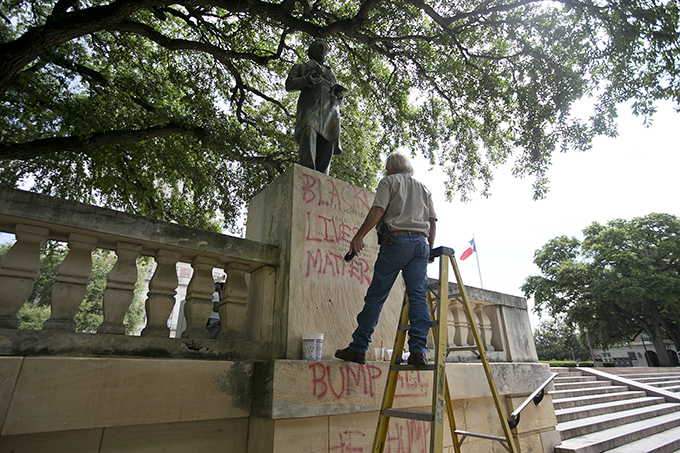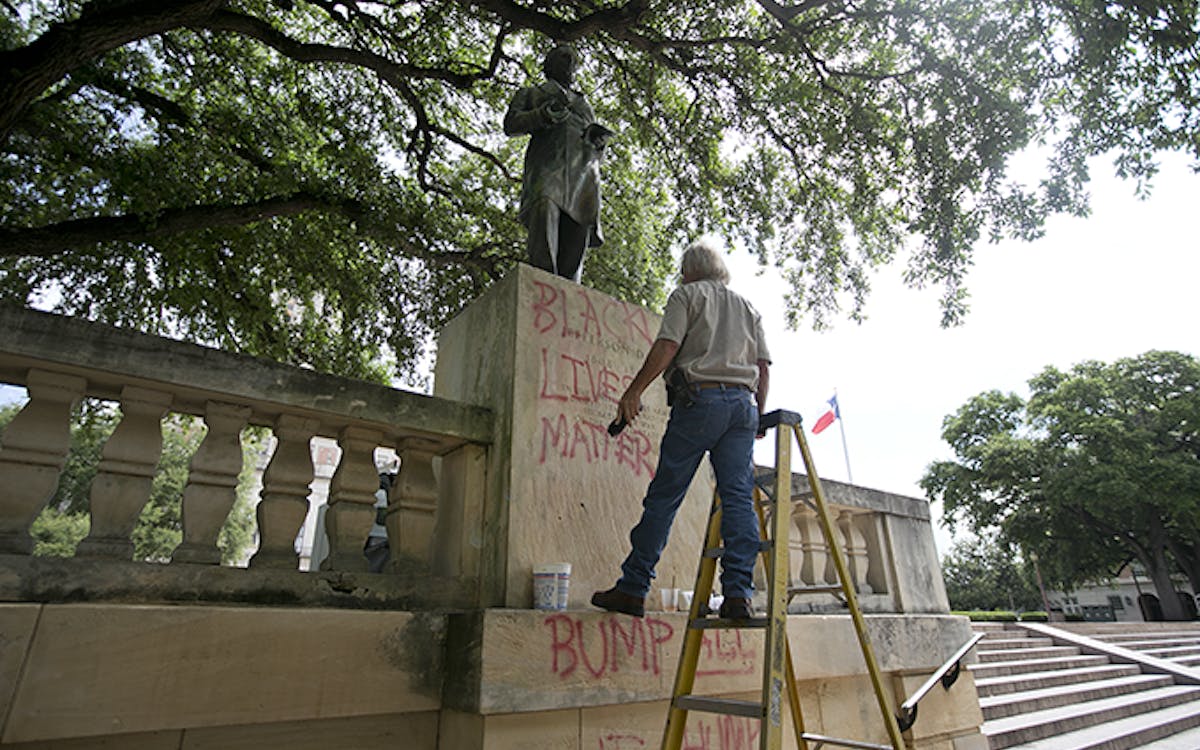
In the aftermath of the Charleston massacre, moves are afoot everywhere to wipe symbols of Confederate history from the map, starting with the Confederate banners that still fly on state flags and/or on public property.
And that flag’s time has come. No matter how many “Heritage not hate!” and “The war was not about slavery” arguments rebel flag proponents put out there, ever since the civil rights era, and much more so since the eighties, that flag has been about a desire for subjugation and a longing for an old order that was barbaric and systematically evil, a powerful symbol for the toxic thoughts and deeds of the KKK, skinheads, and racists not just in the Southern U.S., but all over America and the world.
I say up until the eighties, because there was a brief period there around the Jimmy Carter presidency when the Old South was out and the flag, at least partially, represented a sort of goofy, good ol’ boy New South, at least somewhat politically populist, nonracist, and represented by Hank Williams Jr., Lynyrd Skynyrd, The Dukes of Hazzard, Burt Reynolds car chase flicks, and trucker culture. Imagine if Keith Richards had draped himself in a Confederate flag in front of the Alamo in the last fifteen years rather than 1975, when it apparently caused no stir whatsoever.
But again, after about 1980, the flag was embraced most strongly by Klan rallies, on skinheads’ tattoos, and at neo-segregationist schools, one of which I attended from fourth through eighth grade in Nashville. (We had the flag on our football helmets, our mascot was a rebel, and “Dixie” was our fight song. The mascot has since changed to a panther and the band no longer plays “Dixie.”)
And now, as at my former school and almost every school in what used to be the South, it is time for it to come down, only ever to reappear in museums. As Kathleen Parker wrote in the Washington Post:
To me personally, the flag was offensive long before a mad-boy of evil heart gunned down nine lovely, innocent people as they included him in their prayers. As I wrote many years ago, I was just as afraid of a pickup truck with a Confederate flag in the window as any African-American would be. This is because we all know that the occupants of that truck mean no good by showing that flag. It says: Danger.
The fact that the mere sight of the banner brings pain and humiliation to our African-American neighbors is argument enough to bring it down. But last week’s brutal slayings nullified the pro-heritage argument. Forevermore, there’s no disputing its power as a symbol of racial hatred and the sickness of racism we all have a duty to fight with the same ferocity those soldiers a century and a half ago mustered to end slavery.
So far so good. But how far will this trend go? There is afoot to remove a bust of Nathan Bedford Forrest from the Tennessee Capitol (good riddance: he was a terrific general but terrifyingly racist even by the standard of his times) and statues of Lee and Davis elsewhere, such as Baltimore. Perhaps the most famous visage of Lee, and one of the most renowned Confederate symbols worldwide, is also threatened. New Orleans mayor Mitch Landrieu wants the giant equestrian statue in that city’s Lee Circle to come down.
In Texas, where we have our own iconography and rebel flags were relatively few and far between even pre–Dylann Roof, there are renewed calls to remove other symbols of the Confederacy. The Houston Chronicle called for the renaming of the city’s handful of schools honoring Confederates and a name change for Dowling Street, which honors a rebel soldier and traverses Houston’s Third Ward. Perhaps most prominently in Texas there’s the statue of Confederate president Jefferson Davis that stands on the UT campus. The statue was defaced with graffiti, and a petition for its removal has now garnered more than two thousand signatures.
Davis is only one of a number of racially problematic statues near a fountain honoring their patron, a barely reconstructed former Confederate soldier and slaveholder by the name of George Washington Littlefield. (Who in turn was named for another prominent slaveholder, also represented here.) Rebel generals Albert Sidney Johnston and Robert E. Lee are honored with likenesses, as is Confederate postmaster John H. Reagan. U.S. president Woodrow Wilson, the first Southerner to occupy the White House after Andrew Johnson, stands with the rebels as well.
Where to begin? There’s George Washington Littlefield’s namesake, his own life and career, and the men he chose to honor with this pet project of his: Lee, Reagan, Davis, and Johnston were Confederates, and thus men who fought or labored for the continuation of slavery.
With 20/20 hindsight, some also call them traitors to their country, but I believe that the concept of the United States was not molded into its modern shape until the end of this war. Prior to the war, people said “The United States are a great country”; after came the shift to “The United States is…”. Lee and Johnston were fighting for slavery, but also for Virginia and Texas, which they regarded as much closer to sovereign nations than modern-day states.
But if you accept that they were slaveholders (undoubtedly, as were ten of America’s first twelve presidents) and traitors to the country of their birth (debatable), how would you classify men like Washington, Jefferson, and Madison, slaveholders all, whose break from Mother England was at least as radical as the CSA’s from the USA? And which record on slavery looks better today: Britain’s with regard to its colonies, or our own? And was the entire American Revolution a struggle to maintain slavery in the colonies, as University of Houston history professor Gerald Horne argues in two recent books? And even the Alamo’s official website grants that the Texas Revolution was undoubtedly linked to slavery.
As for Woodrow Wilson, even his natural allies on today’s left rank the progressive Democrat atop a list of the most racist presidents of modern times. And it’s safe to say that were this not so, old man George Washington Littlefield—a former regent at the University of Texas, who dedicated a collection of books largely defending slavery to the university’s library—would not have plunked him down amid his other heroes. (Ironically, Wilson’s inclusion here as the first post-Reconstruction Southern president was intended to show national unity, that the Civil War was truly over, kind of like today’s belief that the election of President Obama ended America’s race problem.)
So, what to do with the South Mall of the UT campus? And what to do with all those Confederate memorials on courthouse squares from the Sabine to the Pecos? As the resting places for many a Confederate veteran, old graveyards are chockablock with rebel iconography. Do we take hammers to those stones?
What about cities like Houston and Austin? While he was a Unionist to the end, Sam Houston owned a dozen slaves at the time of his death, and here is what Stephen F. Austin had to say about the institution practiced by so many of the colonists he brought here:
Negroes can be brought here under indentures, as servants, but not as slaves. This question of slavery is a difficult one to get on with. It will ultimately be admitted, or the free negroes will be formed by law into a separate and distinct class—the laboring class. Color forms a line of demarkation between them and the whites. The law must assign their station, fix their rights and their disabilities and obligations—something between slavery and freedom, but neither the one nor the other. Either this or slavery in full must take place. Which is best? Quien sabe? It is a difficult and dark question.
Is any of our nineteenth-century history something that Southerners and Texans can be proud of? Do we change the names of Austin and Houston and topple their statues? By the same token, do we need to pull down the Washington and Jefferson monuments in D.C.?
Barring a second civil war or revolution, such radical change is unlikely in the extreme, and images of these men have not yet been co-opted by hate groups, at least not indelibly so.
Still, if you had told me 25 years ago that Walmart would be pulling rebel flags from its shelves I would have thought you were insane. And again, it’s a good thing it is doing so. But how far do we follow this logic? With the drive to remove the Davis statue from UT and Lee from that circle in New Orleans, you have to start wondering, where do we draw the line between acceptable and unacceptable levels of slaveholding and support for the Confederacy? Does the stench of slaveholding overpower all the virtues of Jefferson, Madison, Washington, and Lee?
Does Houston get a pass for staying faithful to the Union, or Austin for dying before the Civil War?
Is it better to sweep all of this shameful history under the rug or leave our dirty laundry out for all to see, to ponder, to tell our kids that some of our ancestors thought one way about slavery, were willing to fight and die for such a horrible idea, and that they were defeated by a more enlightened foe? Or maybe we could add more memorials instead of tearing the ones we have down, these new ones honoring the gargantuan contributions of the slaves and their descendants in building this nation. And while we are at it, we could have plaques near the statues of former slaveholders and Confederates telling the whole truth about them:
Says Tom Hall, a South Carolina attorney and film director:
“If you take your 12-year-old to the Capitol and read the plaques on the statues, you’d think, ‘Wow, what a bunch of nice white men!’ It’s almost like their mamas wrote those descriptions,” he said.
“What we need to do is keep these monuments,” Hall insisted. “Keep them up to remind us all. But add to them, tell the truth about who and what they are about. Tell the full truth of our history.”
And in all this agonizing over symbols of a long-dead nation, would we not be better off looking into the fact that yet another deranged and hateful young American man has been able to avoid receiving meaningful mental health care (the right’s favorite explanation for these senseless massacres) and able to get his hands on a gun (the favorite of the left)?
Why can’t we have progress on both those fronts instead of blaming this all on a flag? Yes, the flag’s got to go, but merely driving Dixie down does little more than give off the appearance of having done something.
Meanwhile untreated mental illness, lax gun laws, and racial hatred (more of which is easily accessible today than ever, thanks to the internet) will still be there, festering under that flag we’ve thrown over them in the hopes they would just go away.














You must be logged in to post a comment Login